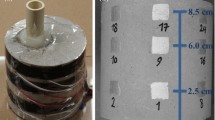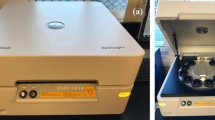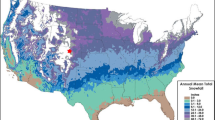Abstract
The deep underground environment has complex geological conditions, which result in cement-based materials under the coupling conditions of high crustal stress, high pressure, and high temperature for the long-term. Thus, the mechanism of water transport is more complicated and often accelerates the deterioration of cement-based materials. In this study, the rules of water transport in mortar with an ultra-low w/b ratio under the coupling conditions of osmotic pressure, confining pressure, and temperature were systemically investigated based on a novel experimental device and low-field NMR technology. Experimental results showed that the saturation of the pore structure and penetration depth of mortar increased rapidly in the early stage (the first 10 min), and the water was mainly filled in nano-scale pores. Low-field NMR imaging technology could be applied to the visualization study of water transport in WPC mortar. With the increase of osmotic pressure and ambient temperature, the penetration rate of water in mortar was significantly increased, and the water was preferentially filled in nano-scale pores with pore sizes less than approximately 200 nm. The increase of confining pressure could improve the permeability of mortar to a certain extent due to the decrease in the penetration rate of water. For water transport in mortar with an ultra-low w/b ratio, the descending order of influence degree of different factors was osmotic pressure, confining pressure, and temperature.











Similar content being viewed by others
References
Zhang ZY, Zou Y, Yang J, Zhou JT (2022) Capillary rise height of sulfate in Portland-limestone cement concrete under physical attack: experimental and modelling investigation. Cem Concr Comp 125:104299
Lv LS, Wang JY, Xiao RC, Fang MS, Tan Y (2021) Chloride ion transport properties in microcracked ultra-high performance concrete in the marine environment. Constr Build Mater 291:123310
Babaee M, Castel A (2018) Water vapor sorption isotherms, pore structure, and moisture transport characteristics of alkali-activated and Portland cement-based binders. Cem Concr Res 113:99–120
Caneda-Martinez L, Medina C, de Rojas MIS, Frias M (2019) Water transport in binary eco-cements containing coal mining waste. Cem Concr Comp 104:103373
Cantero B, Bravo M, de Brito J, del Bosque IFS, Medina C (2021) Water transport and shrinkage in concrete made with ground recycled concrete-additioned cement and mixed recycled aggregate. Cem Concr Comp 118:103957
Wu HX, Yang DY, Xu JG, Liang CF, Ma ZM (2021) Water transport and resistance improvement for the cementitious composites with eco-friendly powder from various concrete wastes. Constr Build Mater 290:123247
Zhang ZD, Angst U (2020) A dual-permeability approach to study anomalous moisture transport properties of cement-based materials. Transp Porous Med 135(1):59–78
Yang L, Zhang YS, Liu ZY, Zhao P, Liu C (2015) In-situ tracking of water transport in cement paste using X-ray computed tomography combined with CsCl enhancing. Mater Lett 160:381–383
Yang L, Gao DY, Zhang YS, She W (2018) Study on water and chloride transport in cracked mortar using X-ray CT, gravimetric method and natural immersion method. Constr Build Mater 176:652–664
Oesch T, Weise F, Meinel D, Gollwitzer C (2019) Quantitative in-situ analysis of water transport in concrete completed using X-ray computed tomography. Transp Porous Med 127(2):371–389
Brew DRM, de Beer FC, Radebe MJ, Nshimirimana R, McGlinn PJ, Aldridge LP, Payne TE (2009) Water transport through cement-based barriers-A preliminary study using neutron radiography and tomography. Nucl Instrum Meth A 605(1–2):163–166
Wang Y, Liu ZN, He FQ, Zhuo WD, Yuan Q, Chen CP, Yang JM (2021) Study on water instability of magnesium potassium phosphate cement mortar based on low-field 1H nuclear magnetic resonance. Measurement 44:109523
Bao JW, Li SG, Yu ZH, Xu J, Li YL, Zhang P, Si Z, Gao S (2021) Water transport in recycled aggregate concrete under sustained compressive loading: experimental investigation and mesoscale numerical modelling. J Build Eng 44:103373
Drouet E, Poyet S, Torrenti JM (2015) Temperature influence on water transport in hardened cement pastes. Cem Concr Res 76:37–50
Gerard B, Breysse D, Ammouche A, Houdusse O, Didry O (1996) Cracking and permeability of concrete under tension. Mater Struct 29(3):141–151
Yang ZF, Weiss WJ, Olek J (2006) Water transport in concrete damaged by tensile loading and freeze-thaw cycling. J Mater Civ Eng 18(3):424–434
Mengel L, Krauss HW, Lowke D (2020) Water transport through cracks in plain and reinforced concrete - Influencing factors and open questions. Constr Build Mater 254:118990
Wang K, Jansen DC, Shah SP, Karr AF (1997) Permeability study of cracked concrete. Cem Concr Res 27(3):381–393
Li SC, Wang Q, Jiang B, He MC, Sun HB, Shao X, Wang CH, Qin Q, Yu HC (2017) Modeling and experimental study of mechanical properties of confined concrete arch in complicated deep underground engineering. Int J Geomech 17(6):04016137
Cho BH, Nam BH, Seo S, Kim J, An J, Youn H (2019) Waterproofing performance of waterstop with adhesive bonding used at joints of underground concrete structures. Constr Build Mater 221:491–500
Zhan PM, Xu J, Wang J, Jiang CH (2021) Multi-scale study on synergistic effect of cement replacement by metakaolin and typical supplementary cementitious materials on properties of ultra-high performance concrete. Constr Build Mater 307:125082
Tahwia AM, Elgendy GM, Amin M (2021) Durability and microstructure of eco-efficient ultra-high-performance concrete. Constr Build Mater 303:124491
Simina M, Molnar L, Manea D, Ardelean I (2012) Monitoring the air influence on cement-lime mortar hydration using low-field nuclear magnetic resonance relaxometry. Appl Magn Reson 43(3):443–450
Wang BM, Zhang Y, Ma HN (2014) Porosity and pore size distribution measurement of cement/carbon nanofiber composites by H-1 low field nuclear magnetic resonance. J Wuhan Univ Technol 29(1):82–88
She AM, Ma K, Liao G, Yao W, Zuo JQ (2021) Investigation of hydration and setting process in nanosilica-cement blended pastes: In situ characterization using low field nuclear magnetic resonance. Constr Build Mater 304:124631
Liu KQ, Yang XS, Zhang H, Yao S, Huang ZL, Zhang XN, Cao Q, Li B, Luo Z, Cheng XW, Yang ZL, Chi CR (2021) Pore connectivity of oil well cement in the early hydration stage by in situ electrical resistivity measurements and low-field nuclear magnetic resonance. Constr Build Mater 303:12448
Zhou CS, Ren FZ, Zeng Q, Xiao LZ, Wang W (2018) Pore-size resolved water vapor adsorption kinetics of white cement mortars as viewed from proton NMR relaxation. Cem Concr Res 105:31–43
Wang YZ, Yang WC, Ge Y, Liu PH, Zhang A (2022) Analysis of freeze-thaw damage and pore structure deterioration of mortar by low-field NMR. Constr Build Mater 319:126097
Zhang A, Yang WC, Ge Y, Wang YZ, Liu PH (2020) Study on the hydration and moisture transport of white cement containing nanomaterials by using low field nuclear magnetic resonance. Constr Build Mater 249:118788
Zhao HT, Wu X, Huang YY, Zhang P, Tian Q, Liu JP (2021) Investigation of moisture transport in cement-based materials using low-field nuclear magnetic resonance imaging. Mag Concr Res 73(5):252–270
McDonald PJ, Istok O, Janota M, Gajewicz-Jarmin AM, Faux DA (2020) Sorption, anomalous water transport and dynamic porosity in cement paste: a spatially localised 1H NMR relaxation study and a proposed mechanism. Cem Concr Res 133:106045
de Cano-Barrita PF, Balcom BJ, Castellanos F (2017) Carbonation front in cement paste detected by T2 NMR measurements using a low field unilateral magnet. Mater Struct 50:150
Mitchell J, Fordham EJ (2018) Sodium-23 NMR in porous media. Microporous Mesoporous Mater 269:109–112
Ji YL, Pel L, Sun ZP (2022) NMR study on the early-age hydration and ion binding of the cement paste prepared with NaCl solutions. Cem Concr Comp 129:104489
Gussoni M, Greco F, Bonazzi F, Vezzoli A, Botta D, Dotelli G, Natali Sora I, Pelosato R, Zetta L (2004) 1H NMR spin-spin relaxation and imaging in porous systems: an application to the morphological study of white portland cement during hydration in the presence of organics. Magn Reson Imaging 22(6):877–889
Wang J, Dong S, Zhou C, Ashour A, Han B (2021) Investigating pore structure of nano-engineered concrete with low-field nuclear magnetic resonance. J Mater Sci 56(1):243–259
Weng L, Wu Z, Zhang S, Liu Q, Chu Z (2022) Real-time characterization of the grouting diffusion process in fractured sandstone based on the low-field nuclear magnetic resonance technique. Int J Rock Mech Min Sci 152:105060
Acknowledgements
The authors gratefully acknowledge the financial support from the National Key Research and Development Program of China (2021YFB2601200), the National Natural Science Foundation of China (52078125, U21A20150, 52293431, 52208228), the Science Foundation for Distinguished Young Scholars of Jiangsu Province (BK20220071).
Funding
National Natural Science Foundation of China, 52078125, Zhiyong liu.
Author information
Authors and Affiliations
Corresponding author
Ethics declarations
Conflict of interest
The authors declare that they have no known competing financial interests or personal relationships that could have appeared to influence the work reported in this paper.
Additional information
Publisher's Note
Springer Nature remains neutral with regard to jurisdictional claims in published maps and institutional affiliations.
Rights and permissions
Springer Nature or its licensor (e.g. a society or other partner) holds exclusive rights to this article under a publishing agreement with the author(s) or other rightsholder(s); author self-archiving of the accepted manuscript version of this article is solely governed by the terms of such publishing agreement and applicable law.
About this article
Cite this article
Liu, Z., Wang, Y., Wu, M. et al. In situ visualization of water transport in cement mortar with an ultra-low w/b ratio under the coupling conditions of osmotic pressure, confining pressure, and temperature. Mater Struct 56, 68 (2023). https://doi.org/10.1617/s11527-023-02145-5
Received:
Accepted:
Published:
DOI: https://doi.org/10.1617/s11527-023-02145-5




